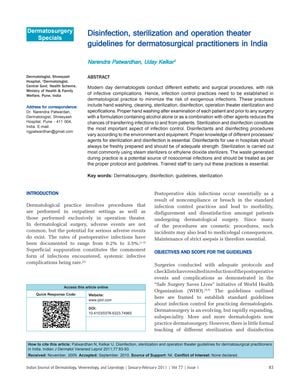Disinfection, Sterilization, and Operation Theater Guidelines for Dermatosurgical Practitioners in India
January 2011
in “
Indian Journal of Dermatology, Venereology and Leprology
”

TLDR Indian dermatosurgical practitioners were given guidelines in 2011 to reduce infection risks, including hand hygiene, sterilization methods, operation theater standards, and proper waste disposal.
In 2011, guidelines were established for dermatosurgical practitioners in India to minimize the risk of postoperative infections, which ranged from 0.2% to 3.5%. The guidelines covered hand hygiene, using agents like chlorhexidine and iodophors, and recommended thorough handwashing or the use of alcohol-based rubs before procedures. Sterilization methods such as steam sterilization and ethylene oxide gas were discussed, with steam being preferred for its non-toxicity and cost-effectiveness. High-level disinfectants like glutaraldehyde and alternatives like hydrogen peroxide were recommended for instrument sterilization. Operation theaters were required to maintain specific environmental controls to reduce airborne particles and infection risk. The document also addressed the importance of proper waste disposal and periodic screening of healthcare personnel for pathogens. Adherence to these guidelines, which include the use of gloves, masks, gowns, and proper footwear, was emphasized as crucial for patient safety in dermatosurgery. The guidelines were adopted with permission from the WHO's "Surgical care at the district hospital."


